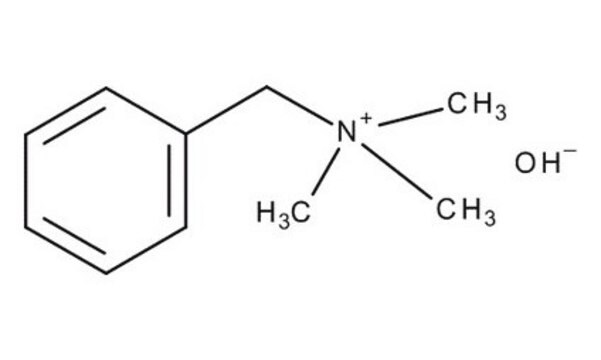B32602
Benzyltrimethylammonium hydroxide solution
40 wt. % in methanol
Synonyme(s) :
N,N,N-Trimethyl-N-benzylammonium hydroxide, N,N,N-trimethyl-1-phenylmethanaminium hydroxide, N,N,N-trimethylbenzenemethanaminium hydroxide, Triton B
About This Item
Produits recommandés
Forme
liquid
Concentration
40 wt. % in methanol
Densité
0.92 g/mL at 25 °C
Chaîne SMILES
[OH-].C[N+](C)(C)Cc1ccccc1
InChI
1S/C10H16N.H2O/c1-11(2,3)9-10-7-5-4-6-8-10;/h4-8H,9H2,1-3H3;1H2/q+1;/p-1
Clé InChI
NDKBVBUGCNGSJJ-UHFFFAOYSA-M
Vous recherchez des produits similaires ? Visite Guide de comparaison des produits
Catégories apparentées
Description générale
Application
- A catalyst in the nitroaldol condensation reaction
- A structure-directing agent in the synthesis of high-silica aluminosilicate zeolite chabazite type zeolite by hydrothermal method
- A ionic liquid precursor for the fabrication of nanostructured ZnO particles
Mention d'avertissement
Danger
Mentions de danger
Classification des risques
Acute Tox. 3 Dermal - Acute Tox. 3 Inhalation - Acute Tox. 3 Oral - Eye Dam. 1 - Flam. Liq. 2 - Skin Corr. 1A - STOT SE 1
Organes cibles
Eyes,Central nervous system
Code de la classe de stockage
3 - Flammable liquids
Classe de danger pour l'eau (WGK)
WGK 2
Point d'éclair (°F)
51.8 °F - closed cup
Point d'éclair (°C)
11 °C - closed cup
Équipement de protection individuelle
Faceshields, Gloves, Goggles
Certificats d'analyse (COA)
Recherchez un Certificats d'analyse (COA) en saisissant le numéro de lot du produit. Les numéros de lot figurent sur l'étiquette du produit après les mots "Lot" ou "Batch".
Déjà en possession de ce produit ?
Retrouvez la documentation relative aux produits que vous avez récemment achetés dans la Bibliothèque de documents.
Les clients ont également consulté
Notre équipe de scientifiques dispose d'une expérience dans tous les secteurs de la recherche, notamment en sciences de la vie, science des matériaux, synthèse chimique, chromatographie, analyse et dans de nombreux autres domaines..
Contacter notre Service technique

![1,8-Diazabicyclo[5.4.0]undéc-7-ène 98%](/deepweb/assets/sigmaaldrich/product/structures/120/564/5b373e23-1624-489c-8efb-692de0f96ffb/640/5b373e23-1624-489c-8efb-692de0f96ffb.png)






![1,4-Diazabicyclo[2.2.2]octane ReagentPlus®, ≥99%](/deepweb/assets/sigmaaldrich/product/structures/366/129/a6ff4175-974d-4fac-9038-b35e508ef252/640/a6ff4175-974d-4fac-9038-b35e508ef252.png)







